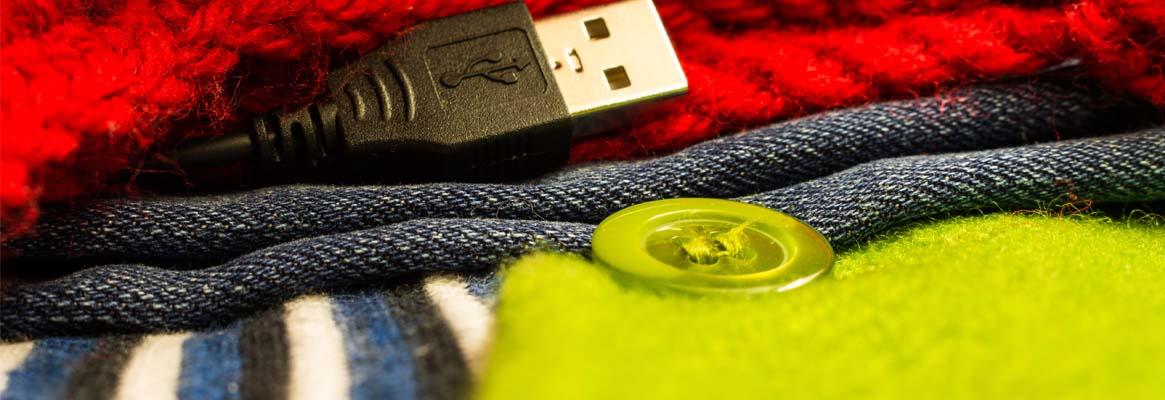Introduction
The original and main function of textiles was to protect our body from environmental conditions like sunrays, cold wind, rain etc. Later on, aesthetic as well as comfort properties came to play a role in clothing. In the new generation of textiles has arisen smart and interactive textiles. These smart textiles help to keep us safe in any extreme environmental conditions, it protects and monitors, sometimes helps to cure injuries or diseases.
Definition
The term "Smart Textiles" refers to a broad field of studies and products which extends there functionality and there use. Smart Textiles are defined as textile products such as fibers, filaments, and yarn which are woven, knitted or non-woven which can interact with the environment or wearer. The combination of textile with electronics which is all known as e-textiles can be applicable to the development of smart material.
"Smart textiles are the fabrics that have been developed with new technologies that provide added value to the wearer".
Smart and interactive textiles
Smart textile is the material which can react to the environment. These are the fabrics which can enable digital components and electronics in itself. Pailes-Friedman of the Pratt Institute states that "what makes smart fabrics revolutionary is that have the ability to do many things that traditional fabrics cannot, including communicate, transform, conduct energy and even grow". The smart textile can sense and react to environmental conditions or stimuli from mechanical, thermal, chemical, electrical, magnetic or other sources. Smart textiles must contain three components i.e. sensors, actuators and control units. Smart textile presents a challenge in several fields such as the medical, sports, military and aerospace.
Types of smart textiles
Smart textiles can be divided into four types based on their functions.
1. Passive smart materials: These are the material which only senses the environmental conditions or stimuli.
These are just sensors such as changing colour, shape, thermal and electrical resistivity.
g. a shirt with in-built thermistors to log body temperature over time.
2. Active smart material: These are the material which can both sense and respond to the external conditions or stimuli.
If actuators are integrated into the passive smart textile, it becomes an active smart textile as it may respond to a particular stimulus.
g. the shirt senses the surrounding temperature. It reacts in the form of rolling up of sleeves when the temperature gets high.
3. Very smart materials: These are materials are able to execute triple functions; first there are sensors which can receive signals, secondly, they are able to give reaction based on the received singles; thirdly they can adapt and changes the shape, size, colour or act according to the given function.
4. Materials with the even higher level of intelligence develop artificial intelligence to the computers.
These kinds of materials are not fully achieved in the current investigation of human beings.
This may be achieved with research and development in the field of textile and electronics. By using the smart fabrics or smart materials with advancement in computer interface this can be possible.
Materials used
The materials which are used to manufacture products of wearable smart textile can interact, communicate and sense.
* Metal fibers * Conductive Inks
* Chromic materials * Coating with nanoparticles
* Organic semiconductors * Shape memory materials
* Optical fibers * Quantum tunneling composites
* Inherently conductive polymers
Conductive threads are mainly used in technical areas like garments, military apparels, medical application and electronic manufacturing. These conductive yarns and fibers are made by mixing pure metallic or natural fibers with conductive materials. Stainless steel filament, metallic silk, organza, special carbon fibers etc are used for manufacturing of fabric sensors. Materials like metallic, conductive polymers, optical fibers supply electrical conductivity, sensing capabilities and data transmission. These materials are resilient, light in weight, flexible, inexpensive and easy to process.
Applications
1. Thermotron
Thermotron of UNITIKA is a particular fabric which is able to absorb sunlight and convert the light energy into thermal energy. It stores heat without wasting it. Inside the thermotron, there are microparticles of zirconium carbide which allow the fabric to absorb and filter sunlight. The inner layer of the fabric holds the heat generated by the fabric and prevents it from going in surrounding atmosphere, thus providing a favorable effect on the human body. It offers a comfortable, waterproof yet breathable wearing experience.
2. Stone Island
Stone island is a jacket which is made to give information about surrounding temperature. It's a liquid crystal heat sensitive coating. At 27 degree census, the molecules which are present in the coating undergo a rotation which modifying the light course. As a result of the colour of the garment gradually begins to change from the dark colour to the much lighter and brighter colour of the fabric base. When the garment returns to its normal temperature, it recovers its original dark coating colour.
3. Polar seal
Feeling cold would be the thing about past there's a product called polar seal which gives instant heat at the touch of a button. There are three different warming levels high, med and low. There are two heating zones one in the upper back and lower back so that we can feel warm in winter. These are easy to use and are tested in alpine conditions. These are flexible, lightweight, breathable and water resistant which makes them ideal for sports or outdoor. These can be worn on gloves or inside shirts. These can keep warm up to 8 hrs in a single charge.
4. ZeroI
Zerol is a cap which is built-in with bone conduction speakers. We don't have to use earphones to listen to music or to make phone calls. As it is a cap our ears are never blocked. It is water resistant, because of which we can also use it while it's raining.
5. ORII
Orii is a ring, by using it we are able to have called. Orii is a voice assistant ring that turns our finger into smartphone all through just a touch to the ear. It uses bone conduction and bone conduction has been used in many medical grade devices. To adjust the ring there are silicon pads incorporated in design which are durable and allergy proof. It has been packed in such a way that it sends vibrations through your finger directly into your ear, so only you can hear. So that allows you to talk and listen just through your finger. There is dual noise-canceling microphone and bone conduction, we can hear and talk even in loud places. By using this we are able to do things like navigation, alarms, translation, texting, weather, messaging, calling, timer, map routes etc. it is water resistant. It has the custom notification, there are four LED lights that can tell us what kind of messages are coming through.
6. Lumo Run
Self-motivation can be runners greatest assets but self-evaluation can be greatest challenge luco run are for those who want to get trained by themselves. Luco run is a motion sensor that collects data and provides motivation all while you run and it fits in a waistband of your shorts. Luco run analyses running biomechanics then suggest judgments on your form that maximises true potential by avoiding any injury. You can access data anywhere which gives full post analyses on the smart phone. We don't need any goggles, smartwatch, wristband no cables.
7. AIO Sleeve
Aio sleeve is a sleeve which can be worn in one hand and gives information which only doctors can give. It gives you self- analyses, sleep duration, quality of sleep on your mobile phone. It can play your favorite music. While workout it measures heartbeat, ECG, steps/distance as well as calories counter. While work it measures your stress level. All these things we are able to see just on your smartphone anytime any place.
8. Invisible Cloak
Japanese scientist at the University of Tokyo has been developing a hi-tech cloak. This invisible cloak is developed by nanoparticles that reflect light, which makes the wearer look invisible. There's a camera fitted on the back the of the cloak which records whatever happens behind the wearer and projects the image on the front of the cloak, creating the illusion that makes wearer looks invisible.
9. Arrow smart shirt
Arrow has manufactured a shirt which looks like any other normal shirt but it has some special features like staying connected just a tap away, being social butterfly, keeping your business card up your sleeve, staying meeting ready, home mode, work mode, pairing with Bluetooth, favorite app just tap away, listening to our favorite song and your favorite play list. All these features are present just on one sleeve. The smart shirt comes with the inbuilt chip on the cuff that can function by downloading the arrow mobile app.
10. Mood dress:
After centuries of wondering scientist are able to design and make a dress that changes colour depending on woman's mood. The sensitive dress was designed by electronics giant Philips. This dress is made up of two layers, the inner layer contains the biometric sensor that picks up a person's mood or emotion and project it by colours on the second layer or outer layer. The emotion such as stress or fear affects the body temperature and sweat level and these generate the light that changes the pattern and colour of the dress. It turns red if you are angry or stressed, or green when you're calm.
The goal of this paper is to focus on the development in the field of wearable smart textiles. Each application of it is unique itself. These applications are friendlier, softer, easy and fashionable.
This article has not been edited by Fibre2Fashion staff and is re-published with permission from textilemates.com




_Small.jpg)


